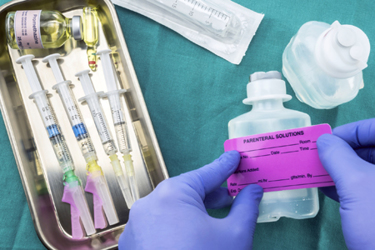New Recommendations For Assessing Extractables & Leachables In Parenteral Drug Products
By Diane Paskiet, chair of Extractables & Leachables Working Group, Product Quality Research Institute

As therapeutics become increasingly complex, so does the challenge of assessing potential risks associated with chemical composition of materials used for drug packaging. The importance of tackling this hurdle — and doing so early in development — can't be overstated.
Leachables in drug or biological products are organic and inorganic chemical compounds that originate from components that are used to store and deliver medicines. The risk of leachables will depend on the composition of the packaging materials, contact solutions, and exposure conditions over time during normal use. Extractables studies are intended to understand the material's chemical composition by forcing constituents out of the packaging materials. This is done under controlled laboratory conditions utilizing various solvents and exaggerating surface contact, extraction, and temperature. All extractables should be considered as potential leachables and assessed for risks.
Drug developers that discover leachables issues in their registration batches will need to mitigate the risk before filing, which can result in lost time and delayed approvals. The quality of the drug product and patient safety can be impacted, and stability studies may need to be repeated, depending on your understanding of the extractables and leachables (E&L).
The final recommendations for E&L in parenteral drug products from the Product Quality Research Institute (PQRI) are designed to help applicants and advance the development process to enable timely submissions and approvals. PQRI is a nonprofit consortium of organizations that brings together members of the pharmaceutical industry, academia, and regulatory agencies to develop science-based approaches to emerging quality and regulatory challenges. Scientists and experts from industry, regulatory agencies, standard setting bodies, and academia collaborate to develop work products in direct support of regulatory guidance.
PQRI's E&L recommendations focus on safety thresholds and best practices that were first introduced in early 2000 by the PQRI Orally Inhaled and Nasal Drug Products (OINDP) Working Group, and these have been widely recognized by industry professionals and regulatory authorities from a global perspective. The threshold concepts for E&L in OINDP were extrapolated for specific characteristics related to parenteral drug products (PDP). The recommendations apply to intravenous (IV), intramuscular, and subcutaneous injectable routes of administration. Detailed explanation of E&L in various PDPs have been illustrated to demonstrate the process for E&L identification and safety assessments that will assist developers to understand and mitigate risk for leachables.1
Establishing Safety Thresholds
PQRI's recommendations for safety thresholds are the result of a 10-year effort by its extractables and leachables working group, which was formed in 2006 with the aim to establish thresholds and best demonstrated practices using science- and risk-based approaches to identify and evaluate leachables. This involves justifying studies that are fit for purpose based on the dose volume administered per day, relative to doses in a container(s) to calculate a threshold for the identification of leachables for toxicological assessment.
As for extractables in packaging components, they're identified by means of rigorous chemical analysis, to understand material composition that may affect drug product quality and patient safety. Determining which extractables could become leachables is often challenging, particularly with large volume parenterals. This is due to the presence of trace leachables, resulting in solutions that may be too dilute for detection. Interferences in trace analysis is problematic, especially in a complex matrices. The PQRI working group demonstrated best practices for designing studies in clean solvents that can simulate the intended use of the final product, thereby narrowing down chemicals to be assessed based on the expectation for probable leachables. PQRI's recommendations for E&L in parenteral products walk drug developers through the various scenarios for evaluation of extractables and leachables for large and small volume parenteral drug products for different applications.
The working group evaluated more than 600 potential extractables and leachables for safety. Three thresholds were developed for PDPs: the safety concern threshold (SCT), or the level below which an organic leachable is present at such low amounts that it presents a minimal safety concern; the analytical evaluation threshold (AET) that is calculated from the SCT and accounts for dosing, which is the level to identify and report leachables for toxicological assessment; and the qualification threshold (QT), which applies to identified leachables that are non-mutagenic nor a sensitizer or irritant, which is the level below which additional safety qualification is not needed.
The recently released recommendations conclude the E&L proposal PQRI published for evaluating extractables and leachables in parenteral and ophthalmic and drug products in 2013.2 There were three key changes, noted below.
1. Systemic Threshold Eliminated
The initial proposal included a 150 micrograms per day systemic threshold for identified leachables, but the E&L database lacked compounds with systemic toxicity and this threshold was eliminated until such time additional systemic E&L compounds can be added to the database.
2. Clarification On Thresholds Applied To Parenteral Routes Of Administration
Another modification to the proposal was the clarification that these thresholds applied to subcutaneous, intravenous, and intramuscular parenteral routes of administration. The more invasive routes of administration, such as intrathecal or intracerebral would need to be evaluated case-by-case based on a risk assessment of product quality and patient safety. At the core of science- and risked-based approaches is the determination of whether product benefits outweigh the potential risks to patients with consideration of uncertainties under the conditions of use. This concept has been further elaborated upon in a recent draft FDA guidance encouraging quality assessment within the therapeutic context and the clinical benefit.
3. Ophthalmic Drug Products Not Treated In Same Manner As PDP
The other key change was that ophthalmic drug products (ODPs) cannot be readily treated in the same manner as PDP. The initial proposal included safety thresholds for ophthalmics, but the E&L database was not sufficient to develop the relevant toxicity endpoints, i.e., sensitization and ocular irritation. The final E&L recommendations are applicable to PDP subcutaneous, intravenous, and intramuscular routes of administration. The overall concepts for safety thresholds are part of the benefit-risk framework, but the justifications and documentation for the AET, extraction conditions, extraction solvents, and analysis should be discussed early with the regulatory agency/division, particularly with consideration of the increasing complexity of pharmaceutical products and delivery systems.
Special Considerations For Biological Products
The PQRI's recommendations for evaluating extractables and leachables include special considerations for biologic drugs, which present several distinctive challenges when it comes to evaluating safety. For example, biologic leachables may not be directly toxic, but they may include chemicals that can alter the biologic attributes of the drug product, thereby changing its function and safety profile. As a result, the PQRI advises that risk assessments for biologics packaging consider biological activity, efficacy, and safety.
To achieve this, drug developers screening for leachables should take into account product quality attributes, such as degradation, oxidation, chemical modification, and immune adjuvant activity. They should also perform assessments of products under conditions related to storage and stress scenarios that may alter chemical interactions with biologic products.
The focus of the PQRI recommendations is on packaging used for pharmaceutical storage and delivery devices, but biomanufacturing equipment can introduce entirely different variables to be considered when assessing safety. The PDP safety thresholds are relative to patient dosing and are not directly amenable to manufacturing equipment; however, understanding the chemistry of materials and components that are used to manufacture the pharmaceutical is a critical aspect to ensure product quality and patient safety.
The last two years have given rise to innovation in pharmaceutical development and manufacture with a glimpse into the future for new technologies. Innovation is on the horizon for E&L assessments; the advances in digitalization, in-silico simulations, and predictive modeling are tools that can be utilized in early pharmaceutical development and change management to make informed decisions throughout the product's life cycle. The drive for accessibility of safe and effective medicines will consider advanced analytics and data sharing that have the potential to eventually shorten the time to market and deliver safe and effective medicines to patients.
References
1. Paskiet D, Ball DJ, Jenke D, et al. Safety Thresholds and Best Demonstrated Practices for Extractables and Leachables in Parenteral Drug Products (Intravenous, Subcutaneous, and Intramuscular), https://pqri.org/wp-content/uploads/2022/03/PQRI-PDP-Recommendation-2022.pdf.
2. Paskiet D, Ball DJ, Jenke D, et al. The Product Quality Research Institute (PQRI) Leachables and Ophthalmic Drug Product (PODP) Extractables Working Group Initiatives for Parenteral and Ophthalmic Drug Product (PODP). PDA Journal of Pharmaceutical Science and Technology, September-October 2013.
About The Author:
 Diane Paskiet is vice chair of the steering committee of the PQRI and chair of its extractables and leachables working group. She has more than 20 years of experience in analytical testing packaging and materials analysis, serving as a project advisor on drug containment systems to support regulatory filings and coordinating R&D plans for technical support of packaging components at West Pharmaceutical Services.
Diane Paskiet is vice chair of the steering committee of the PQRI and chair of its extractables and leachables working group. She has more than 20 years of experience in analytical testing packaging and materials analysis, serving as a project advisor on drug containment systems to support regulatory filings and coordinating R&D plans for technical support of packaging components at West Pharmaceutical Services.
